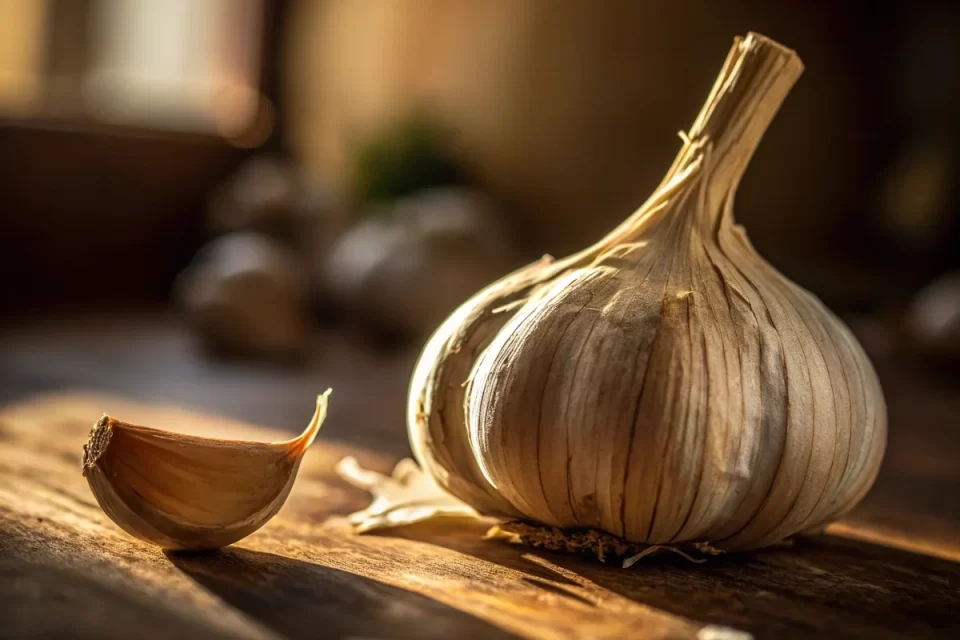Introduction
Garlic (Allium sativum), a pungent bulb revered for centuries, is a cornerstone of global cuisines and traditional medicine. Its distinctive flavor and aroma enhance dishes, while its bioactive compounds offer numerous health benefits. This article explores garlic’s historical role in food, its nutritional profile, evidence-based health benefits, practical tips for use, and complementary food pairings, supported by scientific research.
History of Garlic in Culinary Traditions
Garlic’s culinary use dates back over 7,000 years, originating in Central Asia. Ancient Egyptians included garlic in their diet and used it in mummification processes, as evidenced by garlic bulbs found in Tutankhamun’s tomb (circa 1323 BCE). In Mesopotamia, clay tablets from 2600 BCE document garlic in recipes and medicinal remedies. Ancient Greeks and Romans valued garlic for its flavor and believed it enhanced strength, feeding it to soldiers and athletes. In medieval Europe, garlic was a staple in peasant diets, often combined with herbs to flavor breads and stews. In Asia, garlic has been integral to Chinese, Indian, and Southeast Asian cuisines, appearing in stir-fries, curries, and sauces. Today, garlic remains a universal ingredient, featured in Mediterranean pestos, Middle Eastern hummus, and Latin American salsas, showcasing its versatility across cultures.
Nutritional Profile
Garlic is low in calories but rich in nutrients, making it a valuable addition to a healthy diet. Per 100 grams (approximately 3–4 cloves), raw garlic provides:
- Calories: 149 kcal
- Protein: 6.4g
- Fat: 0.5g (0g saturated)
- Carbohydrates: 33g (2.1g fiber, 1g sugars)
- Vitamins and Minerals:
- Vitamin C: 31.2mg (52% Daily Value)
- Vitamin B6: 1.2mg (71% DV)
- Manganese: 1.7mg (85% DV)
- Potassium: 401mg (11% DV)
- Calcium: 181mg (18% DV)
Garlic also contains small amounts of iron, phosphorus, and selenium. Its bioactive compounds, notably allicin, diallyl disulfide, and S-allyl cysteine, are responsible for its health benefits.
Note: Nutritional values are based on USDA data and may vary slightly depending on garlic variety and preparation method.
Health Benefits
Garlic’s health benefits are supported by extensive scientific research, primarily due to its sulfur-containing compounds and antioxidants. Below are key benefits backed by academic studies:
- Cardiovascular Health: Garlic may reduce blood pressure and cholesterol levels. A meta-analysis in The Journal of Nutrition (2016) found that garlic supplementation lowered systolic blood pressure by 3–9 mmHg in hypertensive individuals. Another study in Lipids in Health and Disease (2013) showed that aged garlic extract reduced LDL cholesterol by 10–15% in adults with high cholesterol.
- Immune Support: Garlic’s antimicrobial and antiviral properties may enhance immune function. A study in Advances in Therapy (2001) demonstrated that garlic supplementation reduced the frequency of colds by 63% compared to placebo.
- Anti-Inflammatory Effects: Allicin and other sulfur compounds in garlic exhibit anti-inflammatory properties. Research in Food & Function (2014) indicated that garlic extracts reduced inflammatory markers like C-reactive protein in animal models.
- Antioxidant Properties: Garlic’s antioxidants, including quercetin and S-allyl cysteine, combat oxidative stress. A study in Nutrition Research and Practice (2017) found that aged garlic extract increased antioxidant enzyme activity in humans, potentially reducing chronic disease risk.
- Antimicrobial Action: Garlic has been shown to combat bacteria, fungi, and parasites. A study in Microbial Pathogenesis (2019) confirmed that allicin inhibited the growth of Staphylococcus aureus and Candida albicans.
Note: While promising, some studies suggest benefits vary based on garlic form (raw, cooked, or supplement) and dosage. Consult a healthcare provider before using garlic for medicinal purposes, especially with medications like anticoagulants.
Tips for Using Garlic
- Maximize Allicin: Crush or chop garlic and let it sit for 10 minutes before cooking to enhance allicin formation, which boosts health benefits.
- Storage: Store whole garlic bulbs in a cool, dry, well-ventilated place for up to 2 months. Avoid refrigerating whole bulbs to prevent sprouting.
- Preparation: Peel cloves easily by crushing them lightly with a knife or soaking in warm water for 5 minutes. Use a garlic press for quick mincing.
- Cooking: Cook garlic over low to medium heat to preserve flavor and nutrients. High heat can make it bitter.
- Odor Control: To reduce garlic breath, chew fresh parsley, mint, or a lemon slice after consumption.
- Moderation: Excessive raw garlic may cause digestive discomfort. Start with 1–2 cloves daily and adjust based on tolerance.
Food Pairings for Garlic
Garlic’s robust flavor complements a variety of ingredients, enhancing both taste and nutrition. Below are five healthy combinations:
- Garlic + Olive Oil + Leafy Greens: Sauté garlic in olive oil with spinach or kale for a nutrient-dense side dish rich in vitamins A, C, and K, plus healthy fats.
- Garlic + Tomatoes + Basil: Combine in a fresh salsa or pasta sauce for a Mediterranean-inspired dish high in lycopene and antioxidants.
- Garlic + Lentils + Onions: Add to lentil soups or stews for a protein-packed meal with fiber and iron, enhanced by garlic’s savory depth.
- Garlic + Salmon + Lemon: Marinate salmon with garlic and lemon juice for a heart-healthy dish rich in omega-3s and vitamin C.
- Garlic + Whole Grains + Herbs: Mix into quinoa or brown rice with rosemary or thyme for a flavorful, fiber-rich base that supports digestion.
Scientific and Academic Support
Garlic’s benefits are well-documented in peer-reviewed research:
- Reid, K., et al. (2016). The Journal of Nutrition: Garlic’s effects on blood pressure and cholesterol.
- Nantz, M. P., et al. (2001). Advances in Therapy: Garlic’s role in reducing cold frequency.
- Amagase, H., et al. (2017). Nutrition Research and Practice: Antioxidant effects of aged garlic extract.
- Bayan, L., et al. (2014). Avicenna Journal of Phytomedicine: Comprehensive review of garlic’s medicinal properties, highlighting allicin’s antimicrobial effects.
- Ankri, S., & Mirelman, D. (1999). Microbes and Infection: Allicin’s antibacterial mechanisms.
These studies confirm garlic’s potential in supporting heart health, immunity, and infection resistance, though further research is needed for long-term effects and optimal dosages.

